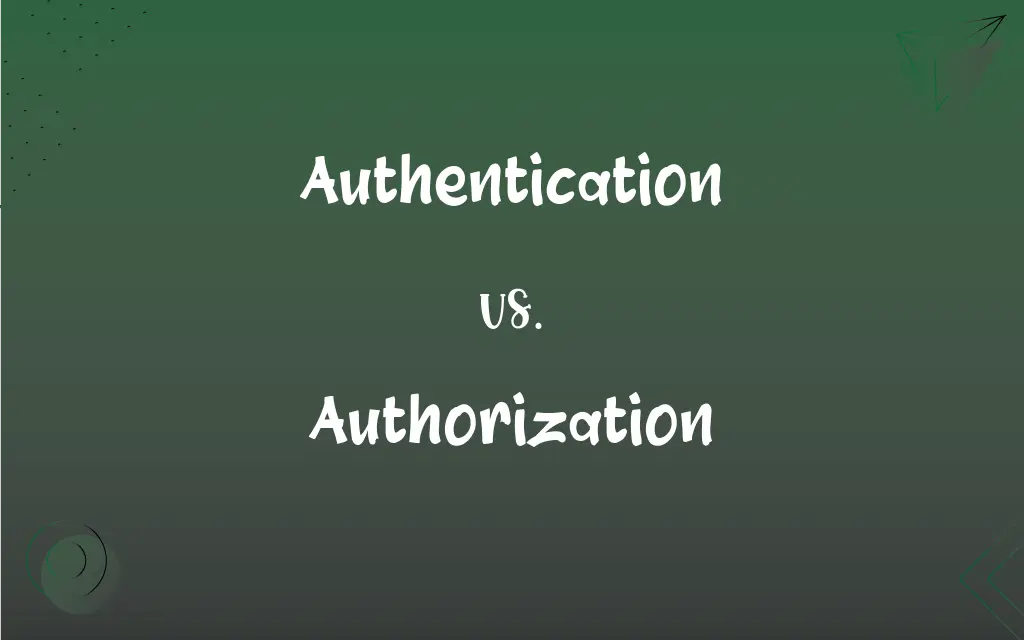Authentication vs. Authorization: What's the Difference?
Edited by Aimie Carlson || By Janet White || Published on November 18, 2023
Authentication verifies identity, ensuring you are who you claim to be. Authorization determines what you're allowed to do after your identity is confirmed.

Key Differences
Authentication and Authorization are foundational components of system security, but they serve distinct roles. Authentication is the process of verifying the identity of a user, system, or application. It's like confirming your identity when you show your ID at a venue. On the other hand, Authorization occurs post-authentication and determines what actions the authenticated entity is permitted to perform.
In the realm of computer systems, Authentication often requires users to provide credentials, such as a username and password. Once these credentials are presented, the system checks them against its database. If they match, the user is authenticated. Authorization, in contrast, is about permissions and rights. After a user's identity is authenticated, Authorization dictates what resources the user can access and what operations they can perform.
Consider this analogy: Authentication is like a bouncer checking your ID at the club's entrance. Once inside (authenticated), Authorization is the rule determining if you can access the VIP area or just the general section. If you don't have the right badge (authorization), you can't enter certain areas, even if the bouncer recognized you.
Online banking offers another clear example. Authentication ensures that you are the account holder by requiring you to log in with your credentials. Once inside, Authorization dictates what actions you can take. Can you view your balance? Transfer money? These are questions of Authorization.
Lastly, it's essential to understand that while Authentication precedes Authorization in many systems, having one doesn't imply the other. You can be authenticated (recognized) but not authorized (given permission) to perform specific actions.
ADVERTISEMENT
Comparison Chart
Purpose
Verifies identity
Determines permissions
Process
Requires credentials (e.g., username/password)
Grants or denies access based on user roles
Analogies
Like checking an ID at an entrance
Like granting access to specific areas
Sequence
Typically occurs before Authorization
Follows Authentication
Outcome
Confirms identity is valid
Allows or restricts actions based on rights
ADVERTISEMENT
Authentication and Authorization Definitions
Authentication
Act of establishing or confirming something as genuine.
Digital signatures provide Authentication for electronic documents.
Authorization
Official permission or approval.
The software requested Authorization before making changes to the system.
Authentication
Process of verifying identity.
Two-factor Authentication adds an extra layer of security to ensure user identity.
Authorization
Act of granting permission.
His manager provided Authorization to access the confidential files.
Authentication
Mechanism to ensure the legitimacy of a user or process.
Facial recognition software offers a modern method of Authentication.
Authorization
Act of validating that someone has access rights.
The badge provides Authorization to enter the secure facility.
Authentication
Confirmation of truth or validity.
Biometric Authentication uses fingerprints to validate a user's identity.
Authorization
Confirmation of a user's right to perform an action.
Once he logged in, his Authorization allowed him to upload files.
Authentication
To establish the authenticity of; prove genuine
A specialist who authenticated the antique samovar.
Authorization
The act of authorizing.
Authentication
Something which validates or confirms the authenticity of something
Authorization
Something that authorizes; a sanction.
Authentication
(computing) proof of the identity of a user logging on to some network
Authorization
(uncountable) Permission.
I've got authorization. Call the office and you'll see.
Authentication
A hallmark or assay-mark on a piece of metalwork
Authorization
(countable) An act of authorizing.
Authentication
A mark on an article of trade to indicate its origin and authenticity.
Authorization
(countable) (A document giving) formal sanction, permission or warrant.
Can I see your authorization?
Authentication
Validating the authenticity of something or someone.
Authorization
(government) Permission, possibly limited, to spend funds for a specific budgetary purpose.
We've had the authorization for years, but we've never gotten an appropriation.
Authentication
A mark on an article of trade to indicate its origin and authenticity
Authorization
The act of giving authority or legal power; establishment by authority; sanction or warrant.
The authorization of laws.
A special authorization from the chief.
Authentication
Validating the authenticity of something or someone
Authorization
A document giving an official instruction or command
Authentication
Validation process to confirm identity.
To access his email, he underwent multiple levels of Authentication.
Authorization
The power or right to give orders or make decisions;
He has the authority to issue warrants
Deputies are given authorization to make arrests
Authorization
Official permission or approval;
Authority for the program was renewed several times
Authorization
The act of conferring legality or sanction or formal warrant
Authorization
Power or right granted.
With the correct Authorization level, she could edit the database.
FAQs
Can someone be authenticated but not authorized?
Absolutely. They can be recognized (authenticated) but not given permission (authorized) for specific actions.
Is a password a form of Authentication?
Yes, a password is a common method of Authentication.
How does two-factor Authentication work?
It requires two forms of identity proof, often a password and a code sent to a mobile device.
How is Authorization different from Authentication?
Authorization determines permissions after identity is authenticated through Authentication.
How can Authentication be strengthened?
By using multi-factor Authentication, biometrics, and strong password policies.
Why is Authorization important in software?
It ensures users can only access and modify data they're permitted to, enhancing security.
Are permissions and Authorization the same?
Permissions are specific rights granted, and Authorization is the overall process of granting those rights.
What happens if Authorization fails?
If Authorization fails, the user is denied access to the requested resource or action.
Is username an Authentication or Authorization factor?
A username is typically an Authentication factor, helping identify the user.
What determines Authorization levels?
User roles, security policies, and access control lists often dictate Authorization levels.
What's the primary purpose of Authentication?
Authentication's main goal is to verify the identity of a user or system.
What's an example of Authorization in daily life?
A library card authorizes you to borrow books—it's a form of Authorization.
Is a biometric scan an Authentication method?
Yes, biometric scans like fingerprint or facial recognition are Authentication methods.
Can you bypass Authentication?
Unauthorized bypassing of Authentication is a security breach and is usually illegal.
Why do some apps require re-authentication?
For enhanced security, ensuring that the user is still the same person in sensitive operations.
About Author
Written by
Janet WhiteJanet White has been an esteemed writer and blogger for Difference Wiki. Holding a Master's degree in Science and Medical Journalism from the prestigious Boston University, she has consistently demonstrated her expertise and passion for her field. When she's not immersed in her work, Janet relishes her time exercising, delving into a good book, and cherishing moments with friends and family.
Edited by
Aimie CarlsonAimie Carlson, holding a master's degree in English literature, is a fervent English language enthusiast. She lends her writing talents to Difference Wiki, a prominent website that specializes in comparisons, offering readers insightful analyses that both captivate and inform.






































































